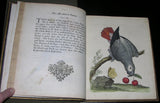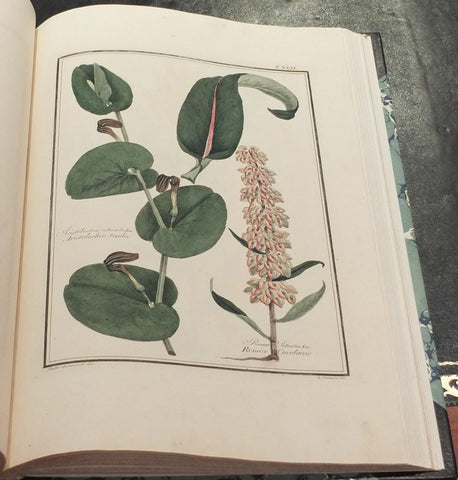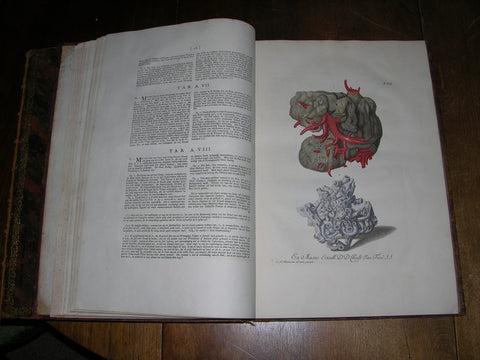Eleazar Albin (FL.1708-1742), A Natural History of Birds... by... Albin... carefully colour'd by his Daughter and Self
Eleazar Albin (FL.1708-1742)
A Natural History of Birds... by... Albin... carefully colour'd by his Daughter and Self.
London: printed for the Author, sold by William Innys, John Clarke and John Brindley, 1731.
4to., (10 6/8 x 8 6/8 inches). With 2 pages of subscribers at beginning (a bit stained), and ephemeral engraved list of plates intended to record delivery of the subscription. 101 fine hand-colored etched plates after Eleazar or Elizabeth Albin and others, colored by the Albins (two plates with professionally closed marginal tears, only one or which affects the plate, some marginal waterstaining to the first gathering, one or two other marginal stains). Contemporary dark green morocco, the covers with a border of acanthus leaves, with Grecian urns at each inner corner, the smooth spine gilt-ruled in seven compartments, the second with a red morocco lettering-piece, the fourth with a gilt-decorated red morocco panel, the others finely decorated with small gold tools, all edges mottled (extremities a bit scuffed, but ATTRACTIVE).
First edition, first issue, with the title-page dated 1731, and making no mention of William Derham's notes.
THE FIRST VOLUME OF THE FIRST BIRD BOOK ISSUED WITH COLOURED PLATES.
Only 89 sets were printed and colored for the original subscribers. The work was eventually completed in three volumes with 306 plates. By the mid-1720s Albin, probably born Weiss, is recorded as living in St Pancras and cultivating connections with gentlemen naturalists, “connections which he put to great use for his A Natural History of Birds...The first two volumes were printed under the patronage of Sir Robert Abdy of Albins (Albyns), Essex (from which village Albin may earlier have taken his Anglicized surname), and the third was greatly supported by Richard Mead (1673–1754), physician to the king. In addition to patronage Albin's connections also provided him with access to the large collections of exotic birds owned by the duke of Chandos, Thomas Lowther, and Joseph Dandridge. Other specimens were often obtained from the Newgate market or a Mr Bland's at the Tiger on Tower Hill, and still others were supplied by sea captains and foreign merchants. A number of live specimens were painted in several London apothecaries' shops and coffee houses. Additionally, in the preface to the first volume, Albin appealed to his readers for specimens, asking that ‘Gentlemen … send any curious Birds … to Eleazar Albin near the Dog and Duck in Tottenham-Court Road’” (Peter Osborne for DNB). Although a number of these exquisite plates are unsigned, all except one (signed by Albin's son Fortin) were probably the work of either Albin or his daughter Elizabeth, the plates were then coloured by members of the Albin family (there were five sons and four daughters in all), and as such the work was the first on birds to use coloured plates and made Albin one of the first successful compilers of the genre of profusely illustrated natural history books for the non-specialist reader: Albin occasionally comments on the taste of his specimens... Famously Albin declined the invitation which Mark Catesby eventually accepted, with great historical and scientific repercussions, for the study of the flora and fauna of America. Cf. BM(NH) p.25; cf. Fine Bird Books (1990) p.71; cf. Mengel 33; cf. Mullens & Swann p.8; cf. Nissen IVB 14.
We Also Recommend








